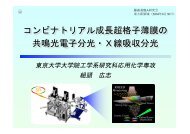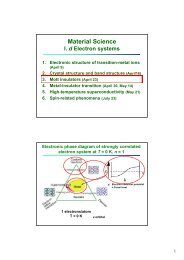Thesis High-Resolution Photoemission Study of Kondo Insulators ...
Thesis High-Resolution Photoemission Study of Kondo Insulators ...
Thesis High-Resolution Photoemission Study of Kondo Insulators ...
Create successful ePaper yourself
Turn your PDF publications into a flip-book with our unique Google optimized e-Paper software.
56 Chapter 4. Evolution <strong>of</strong> Electronic States in the <strong>Kondo</strong> Alloy ...<br />
peak position in going from YbB12 to Yb0.5Lu0.5B12, ∆ is varied from 0.21 eV to 0.28<br />
eV as shown in the lower panel <strong>of</strong> Fig. 4.6 with other parameters fixed. The increase in<br />
∆ with Lu-substitution deduced from the AIM analysis is consistent with the recovery<br />
<strong>of</strong> the B sp DOS near EF in the wide-energy range observed in the He I spectra. The<br />
consistent changes <strong>of</strong> the Yb 4f spectra and the B sp DOS mean that the presence<br />
<strong>of</strong> the 4f-derived spectral weight near EF affects the B sp DOS, which in turn affects<br />
the 4f states on neighboring Yb atoms. That is, the 4f states at different Yb sites<br />
are interacting with each other through the hybridization, indicating that the <strong>Kondo</strong><br />
singlet in YbB12 is not completely localized.<br />
We have also studied the effect <strong>of</strong> gap opening in the conduction band using the<br />
AIM as presented in Fig. 4.9. We opened a narrow (∼ 10 meV) square-well-shaped<br />
gap locating the Fermi level at the middle <strong>of</strong> the gap, and found that the <strong>Kondo</strong> peak<br />
become narrower with its weight (and hence ¯nf) conserved and that the high energy<br />
4f 13 → 4f 12 structure did not change at all. Experimentally we have indeed observed<br />
the narrowing <strong>of</strong> the <strong>Kondo</strong> peak in going from Yb0.5Lu0.5B12 to YbB12 but a substantial<br />
change in ¯nf. Therefore the changes in the 4f spectral line shape with Lu-substitution<br />
does not necessarily imply the opening <strong>of</strong> a narrow gap in the B sp DOS. The absence<br />
<strong>of</strong> the narrow gap in the PES spectra in spite <strong>of</strong> the semiconducting behavior may<br />
indicate that the states near EF are localized due to disorder or that the Fermi level is<br />
located near the bottom <strong>of</strong> the band gap.<br />
According to the AIM, the shift <strong>of</strong> the <strong>Kondo</strong> peak with Lu-substitution should be<br />
accompanied by an increase <strong>of</strong> the <strong>Kondo</strong> temperature. Indeed the temperature where<br />
the magnetic susceptibilities reaches the maximum [4.11] increases by 10-20 K but to a<br />
lesser extent than the shift <strong>of</strong> the <strong>Kondo</strong> peak position. The maximum in the magnetic<br />
susceptibility <strong>of</strong> the insulating Yb1−xLuxB12 might simply have originated from missing<br />
<strong>of</strong> the Pauli paramagnetism owing to the gap opening itself. The validity <strong>of</strong> the AIM,<br />
which has only one characteristic temperature TK, remains to be checked for YbB12.<br />
4.4 Summary<br />
In summary, we have studied how Lu-substitution into YbB12 changes the low-energy<br />
electronic structure. In going from YbB12 to LuB12, the broad dip in the B sp-derived<br />
DOS is gradually filled and the simple Fermi edge is recovered; the <strong>Kondo</strong> peak is<br />
shifted towards higher binding energy. According to the AIM analysis, the change






